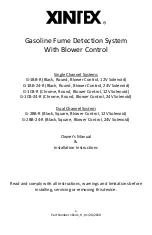
25
Operation and Performance Check
If the Radar has already been correctly configured on a previous occasion then on any
subsequent restart, after around 15 seconds it will enter ''Target Mode" and
approximately 30 seconds later it should start full operation and react to suitable targets.
Correct operation of the Radar should be checked in particular to ensure that:
a) the camera moves to target as expected.
b) zoom and tilt are optimum for different target ranges.
c) detection zone locations and settings are correct.
d) unwanted alarms are absent/minimal.
Performance is best tested with a vehicle as will be more easily picked up by the Radar than
a person walking. Also at large sites, testing performance by walking all round the area can
take a long time. Testing is best done with two people, one providing the target and the
other observing the movement of the camera. Consider using Test Mode (see Section 9, Live
View) to avoid the Radar sensitivity changing while you test (see below).
Other points to make when testing the Radar:
1.
The Radar reacts best when the target is moving away or toward it rather than
around it due to the larger radial velocity of the target causing a larger Doppler shift
in the reflected signal. So just walking/driving around the boundary in a circle will
not necessarily be a good test.
2.
Unless Test Mode has been selected (see Section 9, Live View) then once a targets
crosses an area the Radar will be temporarily (a few minutes) less sensitive in that
area. So testing should not be repeated over the same small patch as this will give an
unrealistic impression of the performance.
3.
Gauging the level of unwanted alarms can be difficult especially if the coverage area
contains vegetation such as long grass, trees or bushes that can move in the wind. In
this case, particularly if it is a still day, don't be tempted to lower the "Target
Threshold" or "Clutter" settings too far (see the Configuration sections).
Create different detection zones for areas that have different characteristics or
requirements and then apply suitable Presets (for Target Threshold and Clutter) so
as to get the best overall site performance.
4.
Close-in performance depends on the installed height. It can be improved by
lowering the installed height (though this may impact longer range performance if
there is obscuration). Consider creating a detection zone near the Radar using a
Preset with low "Target Threshold" or "Clutter" settings - this can improve nearby
sensitivity but won't raise the risk of unwanted alarms in other zones.
Close-in detection may also be artificially improved by setting the "Height" in the
"Radar Settings" web-page to a higher value than the Radar is actually installed at.
If any aspect of the operation is not optimum then reconnect the laptop, launch the Radar
website and then follow the relevant instructions from the configuration sections above. In
particular if the camera is always moving to the wrong bearing then the Alignment (camera
calibration) routine should be repeated.
Predator Radar Installation Manual_V8_1_28_00
Page 49 of 78
© 360 Vision Technology Ltd
















































